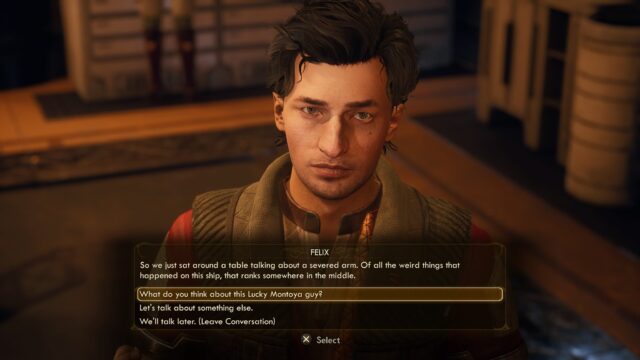The Outer Worlds: Spacer’s Choice Edition Review
You’ve Tried the Best
Private Division and Obsidian Entertainment originally released The Outer Worlds back in 2019, offering a sci-fi take on the modern Fallout formula. With a sequel under development, the companies have given players another opportunity to head into the Halcyon system with the lightly remastered The Outer Worlds: Spacer’s Choice Edition, bringing dedicated versions to PlayStation 5 and Xbox Series X|S bundled with its two DLC expansions. Previous players won’t find anything new from this release, while newcomers will encounter a largely enjoyable title that never hits its true potential.
The Outer Worlds is set an alternate future with a timeline that diverged in 1901, with the result being a hyper-corporate society that has begun its colonisation of space. Players control a colonist in cryostatis on the spaceship Hope, which took the journey to the Halcyon system. However, while another colony ship arrived successfully and established humanity’s presence, the Hope mysteriously vanished with its passengers still frozen. Players are suddenly woken up a few generations later by scientist Phineas Welles, who implores them to help him save the remaining passengers of the Hope and the colony itself, which is falling on hard times thanks to the incompetence and greed of the corporations’ leaders.
This quest soon takes a bit of a back-seat as players first need to find a way to get off the planet Terra 2, where they end up after Phineas jettisons them off the Hope in an escape pod. Here players gain access to their own ship — the encouraging-named Unreliable — and pick up their first companions, while potentially also helping out the populace of the town of Edgewater. The opening stages introduce players to the disparate dystopian state of society as the people are judged solely on their contributions to their company’s bottom-line. Unfortunately, much of the subsequent content doesn’t do anything to build upon or really examine the premise, with many locations lacking in any distinguishable character and being immediately forgotten. One could argue that this is the point and the underlying state of the colony is simply that this is not a fun place to be; but that mood carries over to the audience.
While the base game’s setting and its overall story are entirely forgettable, The Outer Worlds has some strong narrative points. The optional companions are easily the best part of the base game. Each is very likeable in their own way — anyone hurting Parvati deserves whatever comes to them — and have their own interesting stories and development while also providing highly enjoyable commentary on many of the game’s events. The line-to-line writing is generally strong, with plenty of fun correspondence to read through on terminals, but the game overall lacks both proper cohesion and any noteworthy antagonists. Meanwhile, the Peril on Gorgon and Murder on Eridanos DLC add their own locations, characters, and narrative, and are easily the most engaging parts of the release. They happily leap into pulp adventure territory, offering unified locations and themes that are considerably more memorable than those in the main campaign. As one might expect from Obsidian Entertainment’s past work, choices are a large part of the game, but usually amount to whether players want to do what’s best for everyone or to be a selfish jerk. Getting the best results requires some work as well as building up the necessary skills to be able to make those options available, but it is satisfying to achieve.
The Outer Worlds gives players a good amount of freedom with their character builds; they are able to assign points into some base attributes and different types of skills. These attributes and skills have significant impact on the gameplay, be it through the simple numbers of combat, unlocking conversation options, picking locks, hacking computers, and more. Each level players are given ten points to spend upgrading their skills — each skill also offers passive bonuses when upgrading past certain thresholds — and every few levels they are also able to select an additional passive perk. It’s a robust system that allows for players to build up their character as they wish, though there are a few odd spots that aren’t entirely effective and certain skills clearly become more useful for seeing all the game has to offer than others. One fresh element is that once players take enough damage from different sources, they get the option to take flaws, which increase subsequent damage and other effects from the source, but let players pick an additional perk. It’s an interesting idea, but the perks available don’t really justify the cost in taking them, including some that strangely encourage players to not bring companions and eliminate one of the game’s better parts.

Companion interactions and the DLC are where to find The Outer Worlds’s most enjoyable narrative elements.
The game has straightforward equipment systems; players can freely swap between four different weapons and have armour and helmet slots. There are three different ranged weapon types, each using its own type of the abundant ammo strewn around, as well as a variety of melee weapons. The majority of weapons and armour have a number of slots for the many attachments that can be bought or found — adding long-range sights, elemental attacks, skill bonuses, and more — and all can have their base values upgraded for an exponentially increasing money cost. There is a durability system where weapons and armour occasionally need to be repaired, but on the standard difficulty players will easily find way more repair parts than needed. It’s perfectly functional, but there’s nothing particular of note; players will readily be able to find which gear best suits them and move onto more powerful ones as needed, with the rest being largely useless junk that doesn’t offer any upgrade.
Combat feels like a run-of-the-mill first-person shooter and while it adequately performs the job of getting players to wipe out the foes in the way, it doesn’t bother to try and do anything more. Players can act stealthily if they wish, and some quests suggest it, but there’s often no real need to and it frequently ends up being more practical to just go in guns blazing. To drill home the “modern Fallout in space” comparison, the game includes its take on V.A.T.S. with Tactical Time Dilation, where players can slow down time for a short period to look at enemy stats or aim for a particular target. However, The Outer Worlds’s T.T.D. is considerably less powerful than V.A.T.S., further pulling the combat towards feeling more like an action shooter than anything else. Players are further left wanting by the general lack of enemy variety in the game; the fauna of Halcyon is restricted to only a few species and there’s only so many times players can fight off the same selection of robots, humans, and monsters before it gets stale.
There’s not much to the visual action; the game looks fine and throws in a few alien plants and scenery, but there are no places that stick in the memory after moving to the next area, and once players have seen a few monsters, they’ve basically seen them all. Loading times on the PS5 are nice and brief, though there definitely isn’t any notable fidelity improvement over the original release. Audio fares better with strong voice acting, particularly on the companion side, and good sound effects, as well as decent atmospheric music.
To The Outer World’s credit is the good management of its own scope, and this ultimately makes getting through the game much more enjoyable than it might otherwise have been. Instead of giving players vast open swathes, the game’s locations are packed into decently-sized chunks with enough density to give players plenty to investigate without worrying that there might be important things hidden away in far-flung corners. The game can be completed swiftly if players don’t want to engage in all of the potential sidequests, but even doing everything there is — including the DLC — should take most around forty hours.
Despite all of the areas that The Outer Worlds could do better, it is still an enjoyable experience. Companions and the relative density of the game make the day-to-day quests by and large engaging, while the inclusion of the DLC goes a long way to raising up the interest in the setting. However, outside of it there is little to recommend Halcyon as a place to explore, particularly as players get assaulted by familiar foes more than necessary. The Outer Worlds sets a solid, if unspectacular, base that has plenty of room to improve.
Disclosure: This review is based on a free copy of the game provided by the publisher.


Companions are great
Included expansions provide highly enjoyable pulp adventures
Uninteresting combat
Setting and overall story lack character









You’ve tried the best, now try the rest- Spacer’s Choice!